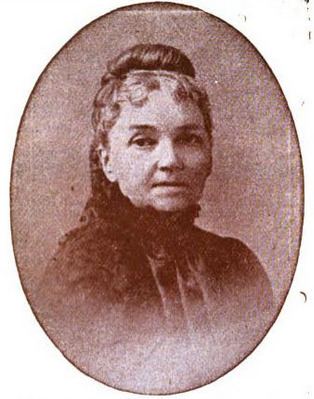Children 2 children | ||
 | ||
Spouses J. William Bradford (m. 1844)Leonidas Ketchum (m. 1858) Books Christmas Carillons: And Other Poems, Lotos-flowers, Gathered in Sun and Shadow Fields Botany, Botanical illustration, Education, Literature, Elocution | ||
Annie Chambers Ketchum (1824-1904) was an American educator, lecturer, and writer. She was a member of the New York Academy of Sciences.
Contents
Early life
Born near Georgetown on November 8, 1824, in Scott County, Kentucky, Annalizah "Annie" Chambers Ketchum was the youngest living daughter of Violetta Bradford and Major Benjamin Stuart Chambers. Major Chambers was one of the twenty who made the "forlorn hope" at the Battle of the River Thames in 1813, one of the six who came out alive from that massacre. Violetta was the eldest daughter of Judge Fielding Bradford of Kentucky who with his brother, John, founded the Kentucky Gazette. In early childhood while growing up at Acacia Grove (now called Cardome), she was often found poring over books which children usually count dull. In the classics she was equally at home with belles-lettres, natural sciences, and mathematics. In modern languages, music and drawing she excelled. She was tutored at home until she attended Georgetown Female College where she graduated with the M.A. degree.
Marriages and Early Career
On December 22, 1844, after her father's death, she married her cousin William Bradford, also known as Joseph Woods Bradford. Only a few years later and after the birth of two children, according to one account, Bradford died and she was left a widow. In another account, she separated from him and was divorced. Subsequently she was appointed in 1855 principal of the High School for Girls in Memphis, Tennessee, where she partnered with the Young Men's High School to establish a co-educational class in elocution. She met Charlotte Cushman, a famous actress who gave her lessons in public speaking. During school vacations she gave a series of popular lectures which then paid for the girls school's equipment for chemistry, physics and astronomy.
Career as Educator, Writer, Lecturer and the Civil War
In 1858, she married Leonidas Ketchum of Memphis. From 1859 to 1861, Mrs. Ketchum served as the founding editor of "The Lotus," a monthly magazine. Her husband enlisted in the Army of the C.S.A. and became an adjutant of the 38th Tennessee Infantry, which led the van at the Battle of Shiloh. There he received the wound which resulted in his death in 1863. When Memphis fell to the Federal army, a British Legation visited the city and Sir Henry Percy Anderson met Mrs. Ketchum whose poetry had become very popular in England. The British delegate asked her to improve up on the latest popular Civil War song, "The Bonnie Blue Flag," and she published the new verses under the title "The Gathering Song." The Federal authorities then arrested Mrs. Ketchum and required her to take the oath of allegiance. Upon her refusal, she and her children were banished from Memphis. She returned north to her native town, Georgetown, Kentucky, and there opened a normal school for advanced pupils.
After the Civil War, she returned to Memphis in 1866 to find her home destroyed. She established a girls school in which she was assisted by her daughter.
Travels in Europe, Development of Botany Textbook and Conversion to Catholicism
In the summer of 1867 her son, who was on vacation from Sewanee where he was studying for the ministry, died of cholera. Upon the sudden death of her son, she left Memphis for Europe, residing for several years in England and France. She documented her journeys while living abroad in a series of articles called "Gypsying" which she sold to American magazines to pay her way.
Upon her return to the U.S., she fixed upon New York City as a place of residence, writing for journals and building up over a hundred lectures on literature, science and art. It was during this time that she published her novel with Lippincott, and her textbook "Botany for academies and colleges: consisting of plant development and structure from seaweed to clematis..." which included illustrations she had made during her visits to European gardens. In Will Hale's 1903 summary of Southern periodicals, he described his great respect for her as a scientist and writer, describing her through the eyes of a woman of his acquaintance: "In 1887 a Philadelphia house brought out Mrs. Chambers-Ketchum's "Botany for Academies and Colleges." During the preparation of that work, I had the honor of entertaining her as a guest in my home. A lady once gave this account of her: 'She has a handsome forehead; mouth large; large black eyes, beautiful more with brilliancy than softness. She is a brilliant talker. ... She is a glorious woman, and a poetess.'"
Eventually, she converted and became a Roman Catholic. While in Paris, France, she became a novitiate in a Dominican convent on May 24, 1876. Because she did not live in a cloister, she became a Capitular Tertiary of St. Dominic. She wore traditional women's clothes but donned a Dominican habit on the Catholic Church's holy feast days and she was buried in it. Her religious name was Sister Amabilis which she used while she continued her intellectual life as a botanist.
Death
Mrs. Ketchum died in New York on November 27, 1904.
Selected works
Ketchum's writings are numerous and include "Nellie Bracken: a tale of forty years ago" (a novel published in 1855 by Lippincott), "Gypsying" (letters of travel), "Christmas Carillons: and other poems" (a volume of poems published by Appleton in 1888), as well as a large number of lectures on science, literature and art. She composed an entirely original work on botany, Botany for academies and colleges: consisting of plant development and structure from seaweed to clematis, as a textbook for academies and colleges, containing in its three hundred duodecimo pages twice as much instruction as could be found in other text-books in use.
